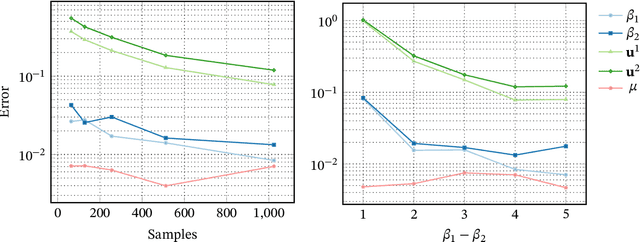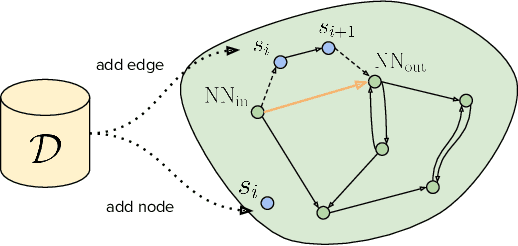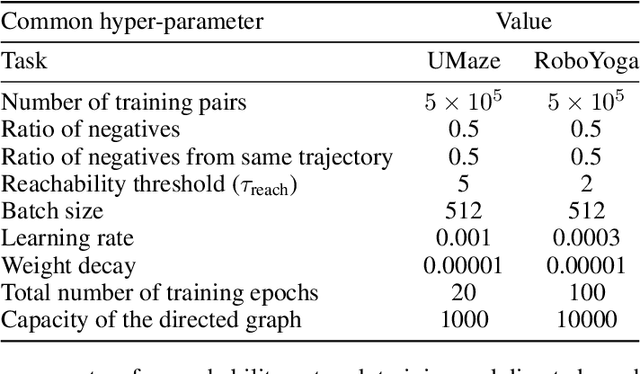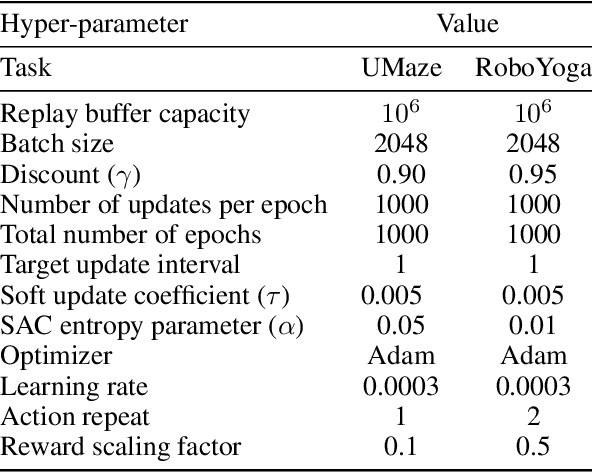Alessandro Lazaric
INRIA Lille - Nord Europe
TD-JEPA: Latent-predictive Representations for Zero-Shot Reinforcement Learning
Oct 01, 2025Abstract:Latent prediction--where agents learn by predicting their own latents--has emerged as a powerful paradigm for training general representations in machine learning. In reinforcement learning (RL), this approach has been explored to define auxiliary losses for a variety of settings, including reward-based and unsupervised RL, behavior cloning, and world modeling. While existing methods are typically limited to single-task learning, one-step prediction, or on-policy trajectory data, we show that temporal difference (TD) learning enables learning representations predictive of long-term latent dynamics across multiple policies from offline, reward-free transitions. Building on this, we introduce TD-JEPA, which leverages TD-based latent-predictive representations into unsupervised RL. TD-JEPA trains explicit state and task encoders, a policy-conditioned multi-step predictor, and a set of parameterized policies directly in latent space. This enables zero-shot optimization of any reward function at test time. Theoretically, we show that an idealized variant of TD-JEPA avoids collapse with proper initialization, and learns encoders that capture a low-rank factorization of long-term policy dynamics, while the predictor recovers their successor features in latent space. Empirically, TD-JEPA matches or outperforms state-of-the-art baselines on locomotion, navigation, and manipulation tasks across 13 datasets in ExoRL and OGBench, especially in the challenging setting of zero-shot RL from pixels.
Zero-Shot Whole-Body Humanoid Control via Behavioral Foundation Models
Apr 15, 2025Abstract:Unsupervised reinforcement learning (RL) aims at pre-training agents that can solve a wide range of downstream tasks in complex environments. Despite recent advancements, existing approaches suffer from several limitations: they may require running an RL process on each downstream task to achieve a satisfactory performance, they may need access to datasets with good coverage or well-curated task-specific samples, or they may pre-train policies with unsupervised losses that are poorly correlated with the downstream tasks of interest. In this paper, we introduce a novel algorithm regularizing unsupervised RL towards imitating trajectories from unlabeled behavior datasets. The key technical novelty of our method, called Forward-Backward Representations with Conditional-Policy Regularization, is to train forward-backward representations to embed the unlabeled trajectories to the same latent space used to represent states, rewards, and policies, and use a latent-conditional discriminator to encourage policies to ``cover'' the states in the unlabeled behavior dataset. As a result, we can learn policies that are well aligned with the behaviors in the dataset, while retaining zero-shot generalization capabilities for reward-based and imitation tasks. We demonstrate the effectiveness of this new approach in a challenging humanoid control problem: leveraging observation-only motion capture datasets, we train Meta Motivo, the first humanoid behavioral foundation model that can be prompted to solve a variety of whole-body tasks, including motion tracking, goal reaching, and reward optimization. The resulting model is capable of expressing human-like behaviors and it achieves competitive performance with task-specific methods while outperforming state-of-the-art unsupervised RL and model-based baselines.
Fast Adaptation with Behavioral Foundation Models
Apr 10, 2025Abstract:Unsupervised zero-shot reinforcement learning (RL) has emerged as a powerful paradigm for pretraining behavioral foundation models (BFMs), enabling agents to solve a wide range of downstream tasks specified via reward functions in a zero-shot fashion, i.e., without additional test-time learning or planning. This is achieved by learning self-supervised task embeddings alongside corresponding near-optimal behaviors and incorporating an inference procedure to directly retrieve the latent task embedding and associated policy for any given reward function. Despite promising results, zero-shot policies are often suboptimal due to errors induced by the unsupervised training process, the embedding, and the inference procedure. In this paper, we focus on devising fast adaptation strategies to improve the zero-shot performance of BFMs in a few steps of online interaction with the environment while avoiding any performance drop during the adaptation process. Notably, we demonstrate that existing BFMs learn a set of skills containing more performant policies than those identified by their inference procedure, making them well-suited for fast adaptation. Motivated by this observation, we propose both actor-critic and actor-only fast adaptation strategies that search in the low-dimensional task-embedding space of the pre-trained BFM to rapidly improve the performance of its zero-shot policies on any downstream task. Notably, our approach mitigates the initial "unlearning" phase commonly observed when fine-tuning pre-trained RL models. We evaluate our fast adaptation strategies on top of four state-of-the-art zero-shot RL methods in multiple navigation and locomotion domains. Our results show that they achieve 10-40% improvement over their zero-shot performance in a few tens of episodes, outperforming existing baselines.
Temporal Difference Flows
Mar 12, 2025Abstract:Predictive models of the future are fundamental for an agent's ability to reason and plan. A common strategy learns a world model and unrolls it step-by-step at inference, where small errors can rapidly compound. Geometric Horizon Models (GHMs) offer a compelling alternative by directly making predictions of future states, avoiding cumulative inference errors. While GHMs can be conveniently learned by a generative analog to temporal difference (TD) learning, existing methods are negatively affected by bootstrapping predictions at train time and struggle to generate high-quality predictions at long horizons. This paper introduces Temporal Difference Flows (TD-Flow), which leverages the structure of a novel Bellman equation on probability paths alongside flow-matching techniques to learn accurate GHMs at over 5x the horizon length of prior methods. Theoretically, we establish a new convergence result and primarily attribute TD-Flow's efficacy to reduced gradient variance during training. We further show that similar arguments can be extended to diffusion-based methods. Empirically, we validate TD-Flow across a diverse set of domains on both generative metrics and downstream tasks including policy evaluation. Moreover, integrating TD-Flow with recent behavior foundation models for planning over pre-trained policies demonstrates substantial performance gains, underscoring its promise for long-horizon decision-making.
System-2 Recommenders: Disentangling Utility and Engagement in Recommendation Systems via Temporal Point-Processes
May 29, 2024

Abstract:Recommender systems are an important part of the modern human experience whose influence ranges from the food we eat to the news we read. Yet, there is still debate as to what extent recommendation platforms are aligned with the user goals. A core issue fueling this debate is the challenge of inferring a user utility based on engagement signals such as likes, shares, watch time etc., which are the primary metric used by platforms to optimize content. This is because users utility-driven decision-processes (which we refer to as System-2), e.g., reading news that are relevant for them, are often confounded by their impulsive decision-processes (which we refer to as System-1), e.g., spend time on click-bait news. As a result, it is difficult to infer whether an observed engagement is utility-driven or impulse-driven. In this paper we explore a new approach to recommender systems where we infer user utility based on their return probability to the platform rather than engagement signals. Our intuition is that users tend to return to a platform in the long run if it creates utility for them, while pure engagement-driven interactions that do not add utility, may affect user return in the short term but will not have a lasting effect. We propose a generative model in which past content interactions impact the arrival rates of users based on a self-exciting Hawkes process. These arrival rates to the platform are a combination of both System-1 and System-2 decision processes. The System-2 arrival intensity depends on the utility and has a long lasting effect, while the System-1 intensity depends on the instantaneous gratification and tends to vanish rapidly. We show analytically that given samples it is possible to disentangle System-1 and System-2 and allow content optimization based on user utility. We conduct experiments on synthetic data to demonstrate the effectiveness of our approach.
Reinforcement Learning with Options and State Representation
Mar 25, 2024



Abstract:The current thesis aims to explore the reinforcement learning field and build on existing methods to produce improved ones to tackle the problem of learning in high-dimensional and complex environments. It addresses such goals by decomposing learning tasks in a hierarchical fashion known as Hierarchical Reinforcement Learning. We start in the first chapter by getting familiar with the Markov Decision Process framework and presenting some of its recent techniques that the following chapters use. We then proceed to build our Hierarchical Policy learning as an answer to the limitations of a single primitive policy. The hierarchy is composed of a manager agent at the top and employee agents at the lower level. In the last chapter, which is the core of this thesis, we attempt to learn lower-level elements of the hierarchy independently of the manager level in what is known as the "Eigenoption". Based on the graph structure of the environment, Eigenoptions allow us to build agents that are aware of the geometric and dynamic properties of the environment. Their decision-making has a special property: it is invariant to symmetric transformations of the environment, allowing as a consequence to greatly reduce the complexity of the learning task.
Simple Ingredients for Offline Reinforcement Learning
Mar 19, 2024



Abstract:Offline reinforcement learning algorithms have proven effective on datasets highly connected to the target downstream task. Yet, leveraging a novel testbed (MOOD) in which trajectories come from heterogeneous sources, we show that existing methods struggle with diverse data: their performance considerably deteriorates as data collected for related but different tasks is simply added to the offline buffer. In light of this finding, we conduct a large empirical study where we formulate and test several hypotheses to explain this failure. Surprisingly, we find that scale, more than algorithmic considerations, is the key factor influencing performance. We show that simple methods like AWAC and IQL with increased network size overcome the paradoxical failure modes from the inclusion of additional data in MOOD, and notably outperform prior state-of-the-art algorithms on the canonical D4RL benchmark.
Layered State Discovery for Incremental Autonomous Exploration
Feb 07, 2023Abstract:We study the autonomous exploration (AX) problem proposed by Lim & Auer (2012). In this setting, the objective is to discover a set of $\epsilon$-optimal policies reaching a set $\mathcal{S}_L^{\rightarrow}$ of incrementally $L$-controllable states. We introduce a novel layered decomposition of the set of incrementally $L$-controllable states that is based on the iterative application of a state-expansion operator. We leverage these results to design Layered Autonomous Exploration (LAE), a novel algorithm for AX that attains a sample complexity of $\tilde{\mathcal{O}}(LS^{\rightarrow}_{L(1+\epsilon)}\Gamma_{L(1+\epsilon)} A \ln^{12}(S^{\rightarrow}_{L(1+\epsilon)})/\epsilon^2)$, where $S^{\rightarrow}_{L(1+\epsilon)}$ is the number of states that are incrementally $L(1+\epsilon)$-controllable, $A$ is the number of actions, and $\Gamma_{L(1+\epsilon)}$ is the branching factor of the transitions over such states. LAE improves over the algorithm of Tarbouriech et al. (2020a) by a factor of $L^2$ and it is the first algorithm for AX that works in a countably-infinite state space. Moreover, we show that, under a certain identifiability assumption, LAE achieves minimax-optimal sample complexity of $\tilde{\mathcal{O}}(LS^{\rightarrow}_{L}A\ln^{12}(S^{\rightarrow}_{L})/\epsilon^2)$, outperforming existing algorithms and matching for the first time the lower bound proved by Cai et al. (2022) up to logarithmic factors.
Learning Goal-Conditioned Policies Offline with Self-Supervised Reward Shaping
Jan 05, 2023



Abstract:Developing agents that can execute multiple skills by learning from pre-collected datasets is an important problem in robotics, where online interaction with the environment is extremely time-consuming. Moreover, manually designing reward functions for every single desired skill is prohibitive. Prior works targeted these challenges by learning goal-conditioned policies from offline datasets without manually specified rewards, through hindsight relabelling. These methods suffer from the issue of sparsity of rewards, and fail at long-horizon tasks. In this work, we propose a novel self-supervised learning phase on the pre-collected dataset to understand the structure and the dynamics of the model, and shape a dense reward function for learning policies offline. We evaluate our method on three continuous control tasks, and show that our model significantly outperforms existing approaches, especially on tasks that involve long-term planning.
* Code: https://github.com/facebookresearch/go-fresh
On the Complexity of Representation Learning in Contextual Linear Bandits
Dec 19, 2022Abstract:In contextual linear bandits, the reward function is assumed to be a linear combination of an unknown reward vector and a given embedding of context-arm pairs. In practice, the embedding is often learned at the same time as the reward vector, thus leading to an online representation learning problem. Existing approaches to representation learning in contextual bandits are either very generic (e.g., model-selection techniques or algorithms for learning with arbitrary function classes) or specialized to particular structures (e.g., nested features or representations with certain spectral properties). As a result, the understanding of the cost of representation learning in contextual linear bandit is still limited. In this paper, we take a systematic approach to the problem and provide a comprehensive study through an instance-dependent perspective. We show that representation learning is fundamentally more complex than linear bandits (i.e., learning with a given representation). In particular, learning with a given set of representations is never simpler than learning with the worst realizable representation in the set, while we show cases where it can be arbitrarily harder. We complement this result with an extensive discussion of how it relates to existing literature and we illustrate positive instances where representation learning is as complex as learning with a fixed representation and where sub-logarithmic regret is achievable.
 Add to Chrome
Add to Chrome Add to Firefox
Add to Firefox Add to Edge
Add to Edge